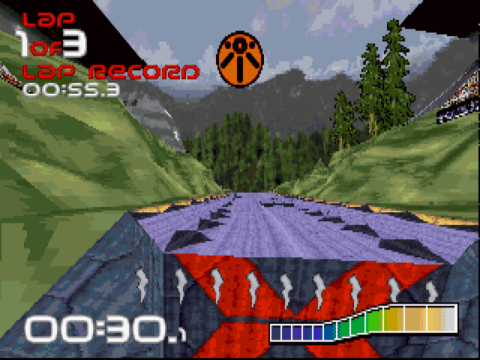
Wipeout
Written by: Rik
Date posted: September 30, 2015
- Genre: Racing
- Developed by: Psygnosis
- Published by: Psygnosis
- Year released: 1995
- Our score: 7
These days you can pretty much expect a basic minimum standard when you buy a multi-platform release, and though there are still arguments about frame rates and technical superiority, the chances of getting something truly, dreadfully, disappointing just because of your choice of machine are fairly slim (as I mentioned here a little while ago, the modern gamer is pretty spoiled in this regard). Many games players of an earlier generation, when arcade games were ported to 8 and 16-bit computers that had little chance of recreating the experience properly, will be able to recall a time when they were seduced by a combination of advertising hype and baseless optimism and shelled out for a home version that proved to be hopelessly inadequate.
I mention dreadful ports because the PC version of Wipeout is always the first to spring to my mind when such things are discussed. The graphics are like someone put the PSX version on the wrong wash cycle, with faded, dull colours, and a few tears in its textures; the controls were next to useless for PC controllers at the time; and the soundtrack was stripped of any licenced music. Most unforgivable, though, was the sluggish frame rate that afflicted the game on even fairly fast-whizzo machines at the time.
The experience must have stayed with me because I’ve slagged it off intermittently on FFG over the years. However, when I last fired it up – to grab some screenshots of what it looked like to play on a 486, as I once did – I noticed that DOSBox was throwing it around at an acceptable speed with all the detail – such as it is – turned up. Diving into the game proper for the first time in a while, it didn’t seem all that bad really. I dug out the PSX version for comparison: obviously, it looks nicer – the PlayStation has loads more colours than VGA’s 256 – and if you play on an emulator you can sharpen up the resolution. But the draw distance and texture issues are still present.
As for the music, for all that the licenced techno is synonymous with the Wipeout series, it turns out there wasn’t quite as much in the original game as I thought. Three licenced tracks – Leftfield’s Afro-Ride, P.E.T.R.O.L. by Orbital and Chemical Beats by The Chemical Brothers – were PlayStation (and UK) exclusives but otherwise the soundtrack was the same, and mostly composed of in-house material (the artist is named as CoLD SToRAGE – but it’s a pseudonym of the Psygnosis sound guy). Maybe the port wasn’t as awful as I’d remembered – it was just low effort, a straight slapping of the game into VGA, minus a bit of music. I also realised that, whatever my gripes, I used to play Wipeout on PC, and this was the experience I wanted to revisit.
I once read somewhere that the main reason to make a futuristic racer was because it was lot easier to write some guff about a future where wheels are outlawed in the manual than actually make a driving game with decent handling. I’m not sure if that’s true, but certainly a lot of the genre has been based around an assumption that future hover racing is somehow cool, without ever managing to provide any evidence to back that up. Wipeout, of course, is the exception: a PlayStation launch game, with an edgy ad campaign, artwork by The Designers Republic, and a thumping techno soundtrack, all of which cemented an association with club and rave culture. (Whatever the hell that is – I did almost sound like I knew what I was talking about there, though, didn’t I?)
As for the game itself, the structure is very much of its time – single race, time trial and championship – with two classes, Venom (quite fast) and Rapier (very fast). You have to win the Venom championship to unlock the Rapier class, and this means accumulating the most points over six races on different tracks, while also finishing in the top three in each. Fail to do so and you lose one of your three lives; when they’re gone, it’s game over [well, duh – FFG reader].
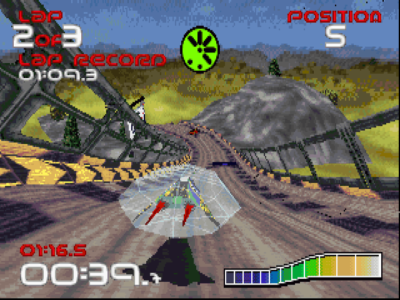
I imagine you’re meant to use the shield when there’s a weapon on the way. Stabbing at the keyboard to turn it on as soon as you’ve picked it up is, I’m sure, also a legitimate tactic.
Wipeout features four racing teams, each with its own craft (the usual variations in top speed, acceleration and handling apply here) and two pilots. The choice of team makes a difference, that of the pilot does not, although they do each get a brief bio in the manual (and I do mean brief: it’s one sentence, occasionally hinting at rivalry between individuals, although by the time we get to the final pilot, team FEISAR’s Paul Jackson, they must have run out of steam because it just says “unconfirmed”. Ooh! The mysterious Paul Jackson! What is his secret?) Named pilots were phased out in later games, although not before one of them gathered a cult following (for more on which see: Five things you probably already knew about Wipeout).
Out on the track, it’s a three-lap affair where the correct racing line is key in order to hit the speed boosts and avoid corner collisions, which are an absolute killer. There are no brakes in the traditional sense, with speed controlled with the throttle and left and right ‘airbrakes’ that shift you sideways assisting with tight corners. Weapons can also be picked up and deployed, although unlike later in the series, they can’t be used to actually destroy your opponents and act only to cause a loss of speed (rockets, mines and missiles) or to mess with the controls (disruptor). (Another attribute of the various craft choices is mass, which determines how well or badly each one is affected by weapons hits). Shields and turbos are also available, and the latter should only ever really be deployed with no corners in sight.
Wipeout is still a great game. Despite the raggedy visuals, the sense of speed and danger remains palpable, even at Venom class. In contrast to the modern career based racer, success is achieved through practice and mastery of each course, each of which is distinctive, particularly the bastard-hard Silverstream, which, I was relieved to hear, is generally considered one of the hardest Wipeout tracks of the whole series – all hairpin turns and uncharitably-placed speed boosts. However, making progress from early efforts, thunking off every corner of the track and thinking “this is actually impossible”, to winning the final race at Silverstream in order to secure the championship, is undeniably rewarding.
In terms of criticisms, it might be said that the game is a bit too forgiving at Venom level (Silverstream excepted) – not necessarily in terms of pulling off perfect laps, but certainly in terms of your opponents’ competitiveness – and too difficult in the Rapier class, which is really fast and sees your opponents hammer you relentlessly with weapons. Some of the tunnels are a bit narrow, for such a fast game, and the way collisions are handled – especially those with opponents – is less than satisfactory (both these flaws were acknowledged by the developers and rectified in future instalments).
Also, as we mentioned, a major bugbear at the time was that control pretty much had to be by keyboard in order to use the airbrakes (the manual’s suggestion that a combination of joypad and keyboard could be used was a fairly laughable one). On the sound front, once you get over the fact that the music isn’t the licensed techno you were expecting (if, indeed, that is what you were expecting), it’s actually pretty good, but music aside there’s really not very much else – there’s no engine noise at all, for example (and it turns out that this is yet another omission from the PSX version that I never noticed first time around, perhaps because the music tends to be quite high in the sound mix by default).
Still, for a game that places so much emphasis on image and style, it says something for Wipeout’s qualities that, when most of that is stripped away, the game still stands up. The series did of course continue, with 1997 sequel Wipeout 2097 considered the strongest by many (the PC version was a better port than this one, but can’t be played these days due to uncontrollable speed-up issues). Beyond that, subsequent titles were both well received and perfectly good games, while at the same time struggling to capture the imagination in the same way as the first two had. Perhaps it was because Wipeout was very much of its time – that time being the mid-90s – and once that passed the series was never really sure whether to continually hark back to it or try and move on.
As far as this one goes, though, while other versions are of course available, the DOS port remains, despite everything, surprisingly playable.

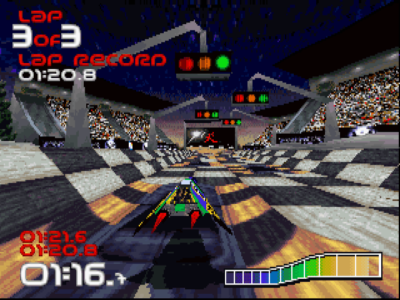
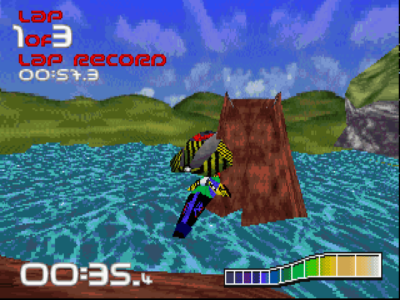
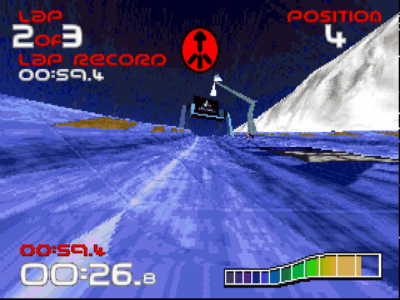
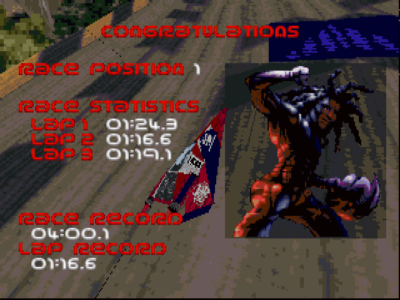

 Posts
Posts